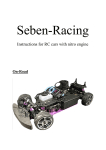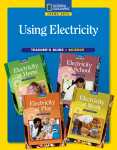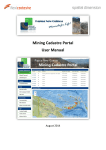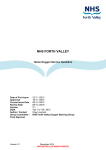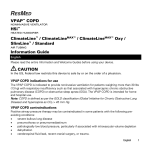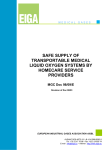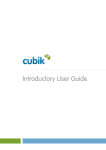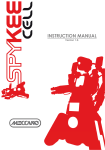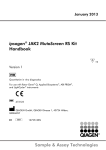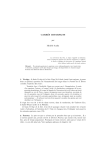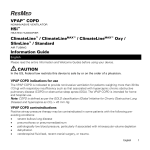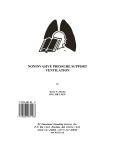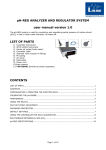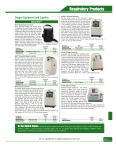Download National Guidance / Best Practice
Transcript
NATIONAL ADVISORY GROUP FOR RESPIRATORY MANAGED CLINICAL NETWORKS DOMICILIARY OXYGEN THERAPY SERVICE NATIONAL GUIDANCE/BEST PRACTICE Version 1 Published: February 2012 Review: February 2014 DOMICILIARY OXYGEN THERAPY NATIONAL GUIDANCE Section: Content: Page: 1.0 2.0 3.0 4.0 5.0 6.0 7.0 8.0 9.0 10.0 Executive Summary Introduction Clinical Indications Primary Care Pathway Secondary Care Pathway Paediatric Oxygen Services Ambulatory Oxygen Short Burst Oxygen Therapy Oxygen Delivery Methods Monitoring and Review of Patients on Home Oxygen 11.0 Out of Hours Oxygen Service 12.0 Discharge Planning 13.0 Anticipatory Care Planning 14.0 Oxygen and Palliative Care 15.0 Withdrawal of Home Oxygen Therapy 16.0 Using Oxygen Therapy – Practical Issues 17.0 Clinical Competence Skills for Oxygen Assessment 18.0 Data Protection 19.0 Alteration to Existing Services 20.0 References Appendices Appendix 1 – Quick Guide: Adult Oxygen Prescription Appendix 2 – LTOT Adult Assessment Specialist Oxygen Service Appendix 3 – Adult Ambulatory Oxygen Assessment Appendix 4 – Equipment Specifications Appendix 5 – Sample Protocol for Withdrawal of LTOT / Ambulatory Oxygen for Adults Appendix 6 – Suggested Oxygen Review Toolkit / Model to Assist NHS Boards Moving Forward with their Oxygen Review for Adults Appendix 7 – Scottish Home Oxygen Order Form (SHOOF) Appendix 8 – Patient Scenarios 1 2 2 2 3 4 8 9 10 10 10 11 11 11 13 13 14 18 18 19 19 20 21 22 23 26 27 29 31 DOMICILIARY OXYGEN THERAPY NATIONAL GUIDANCE 1.0 EXECUTIVE SUMMARY This document has been developed by a subgroup of the National Advisory Group (NAG) for Respiratory Managed Clinical Networks (MCNs) in NHS Scotland, along with a broad range of stakeholders from the British Lung Foundation (BLF), Chest Heart and Stroke Scotland (CHSS), Scottish Government Health Directorates (SGHD), NHS Respiratory Clinicians, Primary Care General Practitioners, and Health Facilities Scotland (HFS). This guidance reflects current good practice in the assessment, review and delivery of home oxygen services and sets out the core components of a high quality assessment and review service for home oxygen. It is aimed at all clinicians and stakeholders who may encounter people who are using home oxygen services and those requiring assessment for consideration of this therapy in the future. 2.0 INTRODUCTION 1 • Oxygen is a drug • Oxygen requires a prescription • Oxygen is a treatment for hypoxaemia. Oxygen may be of symptomatic benefit in breathlessness in the presence of hypoxaemia. Significant hypoxaemia in adults requiring consideration of treatment is conventionally 2 defined as PaO2 < 8kPa ( SpO2 <92% in room air) • Oxygen has no benefit on the symptom of breathlessness in non2 hypoxaemic patients • Long-term supplemental oxygen offers morbidity and mortality benefit in hypoxaemic patients with Chronic Obstructive Pulmonary Disease (COPD) • This document supports best practice for home oxygen provision by NHS Boards in Scotland 3.0 1 CLINICAL INDICATIONS There is no evidence of benefit from oxygen therapy in the absence of 2 hypoxaemia. Hypoxaemia may be due to a number of chronic, mainly respiratory, conditions the most common in Scotland is COPD. 2 DOMICILIARY OXYGEN THERAPY NATIONAL GUIDANCE 3.1 Contraindications In general, provision of home oxygen therapy for treatment of chronic hypoxaemia without distressing symptomatic breathlessness should not occur 1 in smokers - risks in these situations where oxygen is being provided for prognostic purposes are such that it is difficult to justify such provision. Death and serious injury to both the patient, and others, does occur where individuals continue to smoke in the presence of oxygen. In patients who remain distressingly symptomatic with breathlessness, which is relieved by provision of oxygen yet continue to smoke despite maximal effort at smoking cessation, it may be necessary to assess the risk / benefit of oxygen provision, discussing this with the patient, family and carers. In general oxygen should not be provided in these circumstances unless the patient and carers are aware of, and clearly motivated to minimise the potential risks and the evidence of symptomatic benefit is compelling. Individual risk assessment should be undertaken and clearly documented in such circumstances. Children receiving oxygen should not be exposed to tobacco smoke and parental/carer smoking must be strongly discouraged.3 4.0 PRIMARY CARE PATHWAY 4.1 Primary Care Oxygen Assessment Referral Criteria Referral in adults should be based on: • Confirmed diagnosis of the cause of the hypoxaemia, and the patient is in a stable condition • Patients with COPD/other respiratory conditions in the absence of an exacerbation in the last 4 weeks and needs to have an O2 saturation of < 2 92% on breathing air Please see quick guide in Appendix 1 3 DOMICILIARY OXYGEN THERAPY NATIONAL GUIDANCE 5.0 SECONDARY CARE PATHWAY 5.1 Long Term Oxygen Therapy (LTOT) Please see LTOT Assessment Flowchart in Appendix 2 –COPD Clinical conditions that may be referred for oxygen assessment: • Known Chronic Hypoxaemia < 92% SaO2 at rest • COPD – approx. 70% of patients • Interstitial lung disease • Pulmonary vascular disease (including pulmonary hypertension) • Nocturnal hypoventilation as adjunct to ventilatory support techniques (NIV or CPAP) • Severe chronic asthma • Neuromuscular/spinal/chest wall disease • Cystic fibrosis • Bronchiectasis • Pulmonary malignancy • Chronic heart failure • Chronic neonatal lung disease LTOT is indicated in non-smoking patients with COPD if: • PaO2 is < 7.3 kPa when clinically stable2 • PaO2 between 7.3 and 8 kPa when stable and: secondary polycythaemia nocturnal hypoxaemia (oxygen saturation of arterial blood [SaO2] < 90% for more than 30% of time) peripheral oedema (cor pulmonale) pulmonary hypertension Assess the need for oxygen therapy in adults with any of the following: 2 • oxygen saturation <92% breathing air at rest when stable • very severe airflow obstruction (FEV1 < 30% predicted) • cyanosis • secondary polycythaemia • raised jugular venous pressure • peripheral oedema associated with signs of COPD Consider assessment for people with severe airflow obstruction (FEV1 3049% predicted, particularly if there is evidence of right heart failure). Assessment for LTOT should comprise measurement of arterial blood gases on two occasions at least 3 weeks apart in adult patients who have a confirmed diagnosis, who are receiving optimum medical management and 2 are clinically stable. 4 DOMICILIARY OXYGEN THERAPY NATIONAL GUIDANCE Caution: Inappropriate oxygen therapy in some people with COPD may precipitate hypercapnia and respiratory depression. Patients who are hypercapnic or have had an episode of hypercapnic respiratory failure 2 should be issued with an oxygen alert card. In the acute setting (including out of hospital) oxygen should be titrated to a target oxygen saturation of 88-92% pending arterial gas assessment, for these patients. They may be provided with a venturi mask to assist delivery of controlled supplemental oxygen. For chronic, non-emergency situations, the appropriate delivery device should be agreed by the clinician and the service user, considering risks, benefits and practical issues. In general for long-term use, patients find nasal cannulae considerably easier to use than oxygen masks. In circumstances where there is a significant risk of hypercapnia, the convenience and general patient preference for nasal cannulae may need to be balanced against the increased risk of hypercapnia with a fixed flow rather than a fixed performance delivery device. 5.2 Non COPD hypoxaemic patients: Patients who have an established diagnosis on optimal medical treatment who remain hypoxaemic on two separate occasions at least three weeks apart when stable (PaO2 ≤ 8.0 kPa) should be considered for LTOT. The evidence base for length of therapy and outcomes is less robust than for COPD patients. Consider referral for people who are hypercapnic or acidotic on LTOT to a specialist centre for consideration of long-term NIV.1 In patients with COPD, using LTOT evidence supports the use of supplemental oxygen for at least 15 hours per day via the delivery device that best suits the individual’s needs.2 To ensure all patients eligible for LTOT assessment are identified, pulse 2 oximetry should be available in all healthcare settings. Patients receiving LTOT should be reviewed at least once per year by practitioners familiar with LTOT. This review should include pulse oximetry, review of oxygen use and appropriateness of current prescription and delivery device, optimisation of medication /medical therapy, self management and 2 anticipatory care planning. Oxygen concentrators should be used to provide the fixed supply at home for 2. LTOT Liquid oxygen may be prescribed in some cases (generally provision of high flow ambulatory oxygen for the small minority of patients in a position to benefit from this) following specialist clinical and risk assessment. 5.3 Oxygen Prescription 5 DOMICILIARY OXYGEN THERAPY NATIONAL GUIDANCE • Each NHS Respiratory MCN should define who will prescribe LTOT in their Health Authority • Delegated prescribing individuals should also be identified • The Scottish Home Oxygen Order Form (SHOOF) (Appendix 7) should be completed and faxed to HFS 5.3.1 Adults: LTOT for adults with a confirmed diagnosis should only be prescribed 2 following assessment by an appropriately trained respiratory clinician. 5.3.2 Children: Home oxygen for children should only be prescribed following assessment by a paediatrician, neonatologist or cardiologist.3 5.3.3 Oxygen and Chronic Respiratory Disease: Palliative care situations: local solutions will need to be developed for each Health Board. e.g. some palliative care teams will have access to portable concentrators. Some boards may choose to have oxygen concentrators/cylinders placed in cottage hospitals. Oxygen can be delivered within 8 hours in an emergency situation via the national service. See section 14 for further guidance. 5.3.4 Oxygen and Acute Respiratory Situations: • There is no place for prescribing long term home oxygen therapy to acutely ill hypoxaemic patients in primary care. They should be referred for full assessment when clinically stable • Prescribing emergency home oxygen therapy to acutely ill hypoxaemic patients in primary care should only be considered where there are established Hospital at Home /Prevention of Admission services and prescribing decisions are made by suitably qualified clinicians who are identified as delegated prescribing individuals. Appropriate review arrangements must be in place • Patient safety in acute situations should always be considered and discussion with secondary care should be considered in hypoxaemic individuals as they may warrant further discussion/assessment in secondary care 6 DOMICILIARY OXYGEN THERAPY NATIONAL GUIDANCE 5.3.5 Oxygen and Cluster Headache: Oxygen may be prescribed for the acute treatment of cluster headache attacks, high flow oxygen with a flow of at least 10 l/min over 15 min 4 via non rebreather mask for 10-20 minutes. This should only be initiated after consultation with a neurologist. Discussion with a respiratory specialist should be considered before administering high flow oxygen to patients with COPD with known hypercapnoea who have cluster headache. 5.3.6 Prescribing Considerations: • When prescribing oxygen therapy of any modality, consideration should be given to the suitability of the patient and the environment in which the equipment will be used • Oxygen concentrators are dependent on the mains electricity supply which may be subject to delay, disruption or disconnection in unforeseen circumstances, for this reason it is essential that Home oxygen users: Are not dependant on oxygen as a life-supporting mechanism Always have a backup resource (usually a cylinder) in case of the failure of their primary supply Primary oxygen supplies are usually provided by means of a concentrator backed up by a cylinder Liquid Oxygen (LOX) and Babyox service users are encouraged to use a concentrator (backed up by a cylinder) as their primary domiciliary supply, with LOX or Babyox being used for ambulatory purposes However, if Lox or Babyox is utilised as their primary supply, a concentrator should still be in situ (with backup cylinder) as a safety measure The implications of supply disruption should be given due consideration as part of the prescribing process, (irrespective of the modality chosen) and appropriate risk control measures put in place. Local solutions should be considered by Health Boards Further advice and information is available from HFS For safety reasons smoking should not take place within a household where LTOT is being provided. If this is found to be occurring, reassessment of the risks and benefits should be conducted with consideration given to removal of supplemental oxygen. – see section 3.1 7 DOMICILIARY OXYGEN THERAPY NATIONAL GUIDANCE 5.4 Change of Oxygen Prescription In the event that a patient’s prescription should change in any respect, HFS should be advised in order that the records may be changed and the service provider notified. This should be done by completing and submitting a further SHOOF. 6.0 PAEDIATRIC OXYGEN SERVICES Guidelines for home oxygen therapy for children have been published by the British Thoracic Society and present the evidence base for the practice of administering supplemental oxygen to children outside hospital and provide a useful benchmark for local service implementation.3 Oxygen in children should only be commenced by an appropriately trained paediatrician, neonatologist or cardiologist. • The commonest indication for the prescription of home oxygen in childhood is chronic neonatal lung disease (CNLD) (formerly termed bronchopulmonary dysplasia) that follows preterm birth • The target oxygen saturation depends on the condition being treated and the symptoms in older children and should be determined by the paediatric consultant responsible for prescribing long term oxygen and monitored regularly • The decision to prescribe long term oxygen for a child must take account of the aetiology, persistence and potential adverse effect of hypoxaemia • In most cases oximetry is acceptable as a non invasive indication of arterial oxygenation, but arterial or capillary blood gases should be recorded if there is a need to assess any sign of respiratory failure • Most infants on home LTOT require low flow oxygen by nasal prongs throughout the 24 hours. This generally involves an oxygen concentrator with low flow meter in the home and a portable oxygen supply that can be carried by the parent/guardian or used in a nursery setting during the day • For those requiring high oxygen flow rates liquid oxygen (LOX) may be preferable with a humidifier and portable high capacity cylinders for ambulatory use (See Appendix 4 for options to address specific therapy requirements) 8 DOMICILIARY OXYGEN THERAPY NATIONAL GUIDANCE 7.0 AMBULATORY OXYGEN Clinical Indications and Patient Assessment Protocol for Ambulatory Oxygen Therapy (AO) (Please see Appendix 3) Clinical indications for AO 7.1 Existing (Domiciliary Oxygen Therapy (DOT)) Service Users: AO may be offered to people already using LTOT who need to use oxygen 2 outside the home, following assessment by a respiratory clinician. However, in breathless patients with COPD who do not have severe resting hypoxaemia there is little evidence to support the benefits of AO 4. AO is likely to be required for all infants and most children receiving LTOT. 7.2 Ambulatory Oxygen Therapy for Patients who Desaturate on Exercise not on LTOT: Individuals who have a diagnosis of COPD, or other established conditions, e.g. interstitial lung disease, cystic fibrosis or, who desaturate on exercise may be referred for assessment; however there is little evidence for AO use in this group. Patients with only moderate hypoxaemia (PaO2>7.3 kPa) and who are not on LTOT, may exhibit exercise-related desaturation (conventionally defined as a fall in SaO2 of at least 4% below 90%). Prescription of ambulatory oxygen can be considered if there is evidence of exercise desaturation that is corrected by 2 the proposed device, with associated symptomatic benefit. (See Appendix 3). 7.3 Assessment and Monitoring of AO: Adult Patients being assessed for AO should be tested using appropriate physiological testing equipment with respect to infection control policies/procedures, risk assessment and health & safety policy; and that premises are spacious enough to allow for the patient’s capacity for exercise to be assessed safely. Compliance with AO should be monitored to ensure most effective use 2 following prescribing. 9 DOMICILIARY OXYGEN THERAPY NATIONAL GUIDANCE 8.0 • • • SHORT BURST OXYGEN THERAPY (SBOT) There is no evidence to support SBOT (the use of oxygen for short periods 2 of time for symptomatic relief in non-ambulatory circumstances) Short burst oxygen therapy should not be used as a treatment for breathlessness or anxiety in the absence of documented hypoxaemia which is correctable by oxygen Existing users of SBOT should be assessed to see if this therapy is clinically indicated 9.0 OXYGEN DELIVERY METHODS Please see Oxygen Modality Summary Assessment in Appendix 4 10.0 MONITORING AND REVIEW OF PATIENTS ON HOME OXYGEN All patients prescribed LTOT and or AO should receive periodic review from 2 an appropriately trained clinician. Patients who have recently commenced home oxygen therapy should be 2 reviewed within 4 weeks and thereafter at least annually. A recommended oxygen review may consist of: • Clinical history and examination, with particular reference to symptoms • Medication review including inhaler technique when applicable • Pulse oximetry • Arterial/Capillary blood gas where clinically indicated • Review of flow rate of prescribed oxygen • Oxygen modality used • Hours of use of oxygen per day • Spirometry where indicated • Smoking status including passive smoking • Immunisation status • Anticipatory care planning including a resuscitation plan and documentation of discussion 10 DOMICILIARY OXYGEN THERAPY NATIONAL GUIDANCE 11.0 OUT OF HOURS OXYGEN SERVICE • There is no place for initiating long term home oxygen therapy in an OUT of HOURS setting • There may be a place for short term oxygen therapy in acute situations for patients with COPD exacerbations who are hypoxaemic when oxygen saturations are measured and oxygen stopped after the acute episode is settled. This should apply to hospital at home services – i.e. provision of supplemental O2 plus other therapy to permit ESD or avoid admission • These patients require to be closely followed up • Patients who are known to be oxygen sensitive should be issued oxygen with extreme caution and an oxygen alert card recommended 2 • Portable concentrators that are issued should be recovered by the out of hours service within a week as per agreed local protocols 12.0 DISCHARGE PLANNING Where a patient is being considered for oxygen at home they should be referred to respiratory medicine services at the earliest opportunity. Non respiratory specialists should not prescribe home oxygen for adults unless on the local oxygen prescribing register (e.g. cluster headaches 5). 13.0 ANTICIPATORY CARE PLANNING Should be considered for all patients who meet the criteria for LTOT. 6 Standard Response Times for Home Oxygen Services Activity Type Standard Installation Lox Installation and delivery Lox replenishment Standard replenishment Urgent/ Palliative Emergency Installation Definition Items applicable Installation of equipment ≤ 4 All except Lox business days Installation of Lox Lox reservoirs, portables and accessories Scheduled Lox deliveries Lox reservoirs Replenishment of supplies All except Lox Installation ≤ 2 working days All Installation Concentrators, Cylinders 11 Action within: ≤ 4 business days (2) ≤ 10 business days (1)(2) Weekly, fortnightly or monthly schedule. No requirement to place orders (3) ≤ 4 business days (2) ≤ 2 business days(2) 8 hours DOMICILIARY OXYGEN THERAPY NATIONAL GUIDANCE Timescales applicable for Orders received during office hours: Activity Type Emergency Callouts: During and outside office hours Definition Items Time applicable between receipt and action of request Any breakdown, situation or request requiring immediate response All Heath Facilities Scotland office hours are Monday - Thursday 0900-1700, Friday 0900-1600. They are closed on Bank Holidays. (Note that emergency responses are not affected by Bank Holidays). Notes: (1) Reductions to this timescale may be made, subject to due discussion and prior arrangement. (2) At present HFS are unable to process requests received outside office hours or Bank Holidays. However, where a SHOOF is received in the days prior to a public holiday, HFS will use all reasonable endeavours to provide and complete the supply as soon as possible. (3) Emergency / non scheduled requests for deliveries of Lox to existing customers will be handled on a case by case basis with due regards to individual circumstances. (4) The emergency callout service is available 24 hours/day, 365 days / year. Servicing of Oxygen Concentrators: Concentrators will be serviced every three months. The date will be mutually agreed with the customer. The risk assessment process is repeated at every visit. 12 ≤8 hours(4) DOMICILIARY OXYGEN THERAPY NATIONAL GUIDANCE 14.0 OXYGEN AND PALLIATIVE CARE Refer to: • The Gold Standards Framework - Prognostic Indicator Guidance 6 • ACT Guidelines for Children receiving palliative care • Appendix 1 15.0 WITHDRAWAL OF HOME OXYGEN THERAP Y Where it is clear on review that the patient is not hypoxaemic, yet is in receipt of home oxygen (e g SBOT), he or she should be advised to discontinue and other appropriate therapies for breathlessness should be discussed. Where the review indicates that the patient is no longer deriving clinical benefit from the oxygen (either because the patient is not hypoxaemic or they gain no benefit from the therapy), discussion should take place about withdrawing it. Where the patient is not using the oxygen as prescribed, but still fulfils the clinical assessment criteria for LTOT, further education may be required or a reduction in the prescribed use should be considered. See Appendix 5 for protocols which might be used to support this discussion. Where the patient is significantly hypoxaemic but is not compliant with the prescribed oxygen therapy, he or she should be counselled on the merits of the therapy and encouraged to increase usage to the recommended level. Continuation of oxygen therapy should only be pursued if used as prescribed, benefit from ambulatory use, and continued abstinence from smoking. 7 Where an infant or child requires long term oxygen therapy but is denied this through lack of parental or carer concordance a multi-disciplinary case conference may identify additional support or training that ensures appropriate remedial action. If there is persistent failure to ensure the child’s health needs are being met then child protection referral may be justified. When an infant or child has been assessed as no longer requiring supplementary oxygen on a daily basis, the oxygen supply is generally left in the home until confirmation that the child can cope in air during risk periods such as acute respiratory infections. 13 DOMICILIARY OXYGEN THERAPY NATIONAL GUIDANCE 16.0 USING OXYGEN THERAPY (Practical issues for prescribers/oxygen provider and users to consider) 16.1 Safe Storage and use of Oxygen Equipment and Car Insurance 16.1.1 Fire Risks: Consequences of oxygen enrichment: • Materials which are not flammable in air may ignite and /or burn in higher concentrations of oxygen • Materials which will burn in air will burn/ ignite at lower temperatures if the oxygen concentration is elevated 16.1.2 Prevention: Avoid oxygen enrichment by: • Turning off the equipment when not in use • Not permitting oxygen to accumulate on absorbent materials such as clothing, bedding, furniture • Keeping the user environment well ventilated 16.1.3 Flammable Materials: Do not let oxygen equipment come into contact with oils or grease, paraffin based products and NEVER use any form of lubricant (ignition is a greater risk in an oxygen enriched environment) • Do not use or store near any flammable/ oily materials • Do not cover or wipe the equipment with any fibrous material • Protect the equipment by carrying, storing and using in approved carry cases only (where provided) • Wash and dry hands thoroughly before handling any oxygen equipment • Do not use or store the equipment within three metres of: Naked flames Sources of intense heat (e.g. cooker hobs, ovens, heaters etc) • Do not smoke or let others smoke near anyone while using oxygen. This not only presents a fire risk but is seriously detrimental to health • The customer should be advised that the fire brigade will be provided with their details to: Place on record the fact they have Oxygen equipment Conduct a risk assessment / fit smoke alarms where appropriate 16.1.4 Physical Safety: Avoid the risks of tripping over, or blocking the supply tubing by: • Keeping the tubing as short as is practicable, however longer tubing to allow mobility within the home may be considered following risk assessment • Using a fixed install where appropriate Responsible adults must be vigilant that other children and any animals are supervised when in the vicinity of the child on oxygen as the risk of injury exists for all. 14 DOMICILIARY OXYGEN THERAPY NATIONAL GUIDANCE 16.1.5 Carrying / Transporting Equipment: • Use only approved devices for carriage and transport • Secure items in transit so they are not free to move 16.1.6 Toppling Over: • Ensure items are placed on a flat and robust surface where necessary to avoid overbalancing 16.2 Transport of Oxygen Equipment on Public Transport and in a Private Vehicle 16.2.1 Advice to be given to the Patient /Carer: • Only carry sufficient oxygen for the journey • Ensure you are trained in the correct method of operation of the equipment • Be aware of the appropriate precautions to be taken whilst using the oxygen equipment on public transport and in the event of an incident • Understand the risks associated with oxygen enrichment • Turn off the equipment when not in use • Ensure that the equipment is secure, not free to roll about, and where required, is supported upright 16.2.2 The Oxygen Equipment should be used: • As described in the user manual • In a carrying bag to keep the cylinder / vessel secure • With the delivery tubing as short as possible • With the appropriate permission where required for use in tunnels 16.2.3 They should not: • Leave the equipment unattended • Allow anyone to tamper with the equipment • Use a humidifier • Cover the equipment with any clothing, bags or other material 16.2.4 In Private Transport, in addition to those above: • Ensure that the user and the driver are trained in the correct method of operation of the oxygen equipment • Use the equipment with the vehicle ventilation system set to draw in fresh air from outside the vehicle • Do not allow anyone to smoke in the vehicle • Do not use the oxygen equipment whilst the vehicle is being refuelled 15 DOMICILIARY OXYGEN THERAPY NATIONAL GUIDANCE 16.2.5 Prescription and Flow Rates: The patient should be advised not to change their prescription without consulting their clinician. Finally, if the patient is at risk from high flow rates of oxygen they should be issued with an Oxygen Alert Card by a respiratory clinician and carry it with them at all times. This can be downloaded free of charge from: http://www.brit-thoracic.org.uk 16.3 Holidays - Air Travel Insurance 16.3.1 Travel Insurance Basic travel agent holiday insurance may not be able to provide adequate cover for people with existing medical conditions. More specialised insurance policies are more suitable. It is worth shopping around for the best deals. It is important to check exactly what your cover will provide. See the Chest Heart Stroke Scotland fact sheet ‘Sympathetic Insurance Companies’ for more information. 16.3.2 Air Travel and Oxygen Therapy There is a wide variation between different airlines in the terms and conditions 3 under which oxygen may be carried and used. It is the customer’s responsibility to make arrangements not only for in-flight provision but also for transit and transfers within the airport(s) and on to the 4 plane(s). There are several private oxygen providers who can facilitate this; however the costs must be met by the traveller as no provision for this service is made within the National Health Service. 4 A Hypoxic Challenge assessment (fitness to fly assessment) should be 8 considered in all patients receiving LTOT prior to air travel being considered. 16.3.3 All Modes of Travel (includes but not restricted to Aircraft, Trains, Cruise Ships, Ferries) Many travel agencies, airlines and other operators have dedicated help lines for customers with particular requirements. Further airline specific advice can be found here: http://www.european-lung-foundation.org/4059-european-lungfoundation-elf-air-travel.htm 16 DOMICILIARY OXYGEN THERAPY NATIONAL GUIDANCE Travellers who use oxygen should contact their chosen travel agency/airline as soon as possible when planning any travel to establish what their policies and capabilities are. It is important that the customer: • Contacts the respective customer service department(s) to obtain a copy of their policy • Ensures that their equipment is on their list of authorised items • Obtains the necessary authorisation and has documentation in situ well in advance of the travel date For more information about travelling with oxygen call the British Lung Foundation on 08458 50 50 20 or visit www.lunguk.org and ask for a free copy of their guide – “Going on Holiday with a Lung Condition”. Also phone the Chest Heart & Stroke Scotland Advice Line 0845 077 6000 and see the fact sheets ‘Air travel for those affected by chest heart or stroke conditions’ and ‘ Holiday Information’ or visit www.chss.org.uk 16.3.4 Holiday Supplies A patient (or by proxy, their Carer or Health Care Professional (HCP)) may request a short term supply of oxygen for use on holiday within the U.K. Provided that they require oxygen modalities that are included in their original Oxy One form, and their flow rate has not changed, this supply can be made without requiring a new Oxy One prescription to be completed. However, should an alternative modality be requested, or a change in flow rate, a new Oxy One should be completed by a HCP and sent to HFS. Please see the chart overleaf to clarify the process. The patient should: • Provide full details of the temporary address • Provide the dates for which they require the equipment • Confirm that they have obtained permission of the owner of the property to allow the use of the equipment. This is particularly relevant if Lox has been requested • Obtain permission from the owner to have the equipment delivered before their arrival and have it collected after their departure • CHSS produce a fact sheet ‘Holidays’ which has been compiled to provide patients and their family or carer(s), with some useful contacts to help to arrange a well-deserved break. Some organisations will make all arrangements including travel and assistance; others will just take bookings for their own accommodation 16.3.5 Travelling with Portable Oxygen Cylinders Patients requiring portable oxygen cylinders for their holiday travel should be provided with a supply of cylinders sufficient to last the outward and return journeys. (http://www.healthcareimprovementscotland.org/home.aspx) 17 DOMICILIARY OXYGEN THERAPY NATIONAL GUIDANCE 17.0 CLINICAL COMPETENCE SKILLS FOR OXYGEN ASSESSMENT Competence requirements for the workforce who will carry out oxygen assessment/prescribing and follow up services: • Undertake clinical assessment (history and examination) of respiratory disease, together with measurement and interpretation of spirometry • Estimation and interpretation of oxygen saturation using pulse oximetry • Competent to perform and interpret arterial and capillary blood gases • Safe and effective administration of oxygen therapy • Assess response to oxygen therapy • Safe and effective prescribing of oxygen and delivery devices • Providing advice and guidance to individuals/carers on safe and effective oxygen therapy • Assessment of risk involved in the provision of oxygen • The necessary skills and competencies are likely to be shared among the local team responsible for oxygen therapy supervision and guidance recommends identification of key responsibilities and accountability 18.0 DATA PROTECTION The Oxygen Therapy Service relies on the participation of third parties for effective management of its operations. The patient should be advised that: • It may be necessary to pass their details to other professionals directly involved in the provision of their healthcare and preservation of their safety • Personal information will NOT be passed to others who do not have a legitimate interest in their healthcare or their safety • Typical agencies involved in this process include, but are not restricted to: Health Facilities Scotland Dolby Vivisol, the current service provider The client’s electricity provider in case of power failure in adverse weather conditions The local Fire and Rescue authority Child Care and Education staff Note: This is a requirement under the data protection act, and is not to be confused with gaining informed consent for treatment. 18 DOMICILIARY OXYGEN THERAPY NATIONAL GUIDANCE 19.0 ALTERATION TO EXISTING SERVICES A suggested oxygen review toolkit / model to assist NHS Boards moving forward with their oxygen review for adults is included as Appendix 6. In addition, a summary of the various scenarios in which patients may receive oxygen is included as Appendix 8. The summary sets out the existing supply mechanism and details how this would be addressed under the new arrangements. 20.0 REFERENCES 1. BMJ Group and Pharmaceutical Press (2011). British National Formulary 61 2. National Clinical Guideline Centre (2010). Chronic Obstructive Pulmonary Disease: Management of chronic obstructive pulmonary disease in adults in primary and secondary care. London: National Clinical Guideline Centre 3. British Thoracic Society Guidelines for Home oxygen in children. 64 Issue Supp lII THORAX August 2009. www.brit-thoracic.org.uk/guidelines/home-oxygen-in-children-guid 4. Moore et al 2011. A randomised trial of domiciliary, ambulatory oxygen in patients with COPD and dyspnoea but without resting hypoxaemia Thorax 2011;66:32-37 doi:10.1136/thx.2009.132522 5. EFNS guidelines on the treatment of cluster headache and other trigeminal autonomic cephalalgias European Journal of Neurology 2006, 13: 1066– 1077 6. The Gold Standards Framework. Prognostic Indicator Guidance Vs 5 (2008).http://www.goldstandardsframework.nhs.uk/OneStopCMS/Core/Cra wlerResourceServer.aspx?resource=B8424129-940E-4AFD-B97A7A9D9311BC25&mode=link&guid=eae1921fd0694340841dbfc891be1047 [accessed 25th July 2011]. 7. Department of health. Home Oxygen Service - Assessment and Review Good practice guide 2011. http://www.pcc.nhs.uk/uploads/HOS/2011/04/home oxygen service assessment and review v3.pdf 8. British Thoracic Society (2002). Managing Passengers with Respiratory Disease Planning Air Travel 9. Clark, A.L, Johnson, M.J., Squire, I. (2011) Does home oxygen benefit people with chronic heart failure? British Medical Journal. 342 pp.379-383. 10. Francis, G.J., Becker, W.J., Pringsheim, T.M. (2010) Acute and preventative pharmacologic treatment of cluster headaches. Neurology. 75 (5) pp.463-473. 19 DOMICILIARY OXYGEN THERAPY NATIONAL GUIDANCE 1,2,4,5,7,8,9 Appendix 1 - Quick Guide: Adult Oxygen Prescription All patients should have their smoking status updated and documented at time of prescription. Patients who smoke should be referred to smoking cessation services. Do not prescribe/refer current smokers for oxygen therapy for health and safety reasons or as a means of incentivising smoking cessation. Hypoxaemia is defined as PaO2 < 8kPa ( SPO2 <92% in room air). Hypoxaemia due to COPD Hyp o xa e m ia d u e to o th e r c a u s e (e .g . n e u ro m u s c u la r) No n COP D Home Oxygen Therapy Maximise therapy as per current guidelines Does the patient have any of: • Sp02 ≤ 92% on air • FEV1< 30% • Polycythaemia • Peripheral oedema • Cyanosis • Raised JVP No Patients on LTOT Refer back to Oxygen Service for reassessment and follow up Yes Consider: • Pulmonary rehabilitation • Self-management • Symptom palliation • Referral to secondary care for management advice (not 02 assessment) • LTOT assessment may still be necessary` Palliative care Should only be considered for hypoxaemic patients who have an established diagnosis and who are distressed by breathlessness unrelieved by other therapy Refer to specialist Oxygen Service Long Term Oxygen Therapy (LTOT) via an oxygen concentrator will be prescribed at a suitable flow rate Portable oxygen will be prescribed if appropriate Homefill, Liquid Oxygen, Portable concentrator or Cylinder with or without Conserver will be provided 20 Prescribe an oxygen concentrator through HFS Not indicated for: • Recovery from seizure/epilepsy • Heart Failure (unless palliative) Cluster Headaches: Refer to neurologist in Secondary Care for assessment and prescription of High Flow (100%) Oxygen DOMICILIARY OXYGEN THERAPY NATIONAL GUIDANCE Appendix 2 - LTOT Adult Assessment Specialist Oxygen Service NO Established Respiratory diagnosis? YES Consider differential diagnosis NICE guidelines – FEV1 <30% (Ve ry s e ve re a irflo w o b s tru c tio n ) Cya n o s is P e rip h e ra l oedema (Polycythemia) Stopped smoking > 3 months Pulmonary rehabilitation Optimise therapy Consider differential diagnosis If still smoking Refer to Smoking Cessation YES • • • • • Refer Respiratory Clinician for assessment Arterial blood gas analysis Carboxyhaemoglobin Assess risk factors/safety issues Social Circumstances If Pa03 <7.3P a o r 7.3 – 8.0 kP a + a d d itio n a l ris k fa c to rs Re c h e c k a rte ria l b lo o d g a s e s >/ = 3 we e ks YES If c rite ria m e t o rd e r LTOT Re s p ira to ry Nu rs e S p e c ia lis t fo llo w u p a p p ro x 2 we e ks P o s t d e live ry Ad d to LTOT Re g is te r Oxyg e n Ale rt Ca rd a s a p p ro p ria te If Pa02 >8.0 kP a + n o a d d itio n a l ris k fa c to rs NO No t fo r LTOT a t p re s e n t tim e Re -re fe r if d e te rio ra te s BORDERLINE Prescribe Oxygen Using Form If ABG borderline/co-morbidities but no risk factors, discuss with Respiratory Physicians (a decision will be made on clinical grounds) 21 Appendix 3 ADULT AMBULATORY OXYGEN ASSESSMENT No evidence for AO: Chronic Lung Disease with Mild Hypoxaemia and No Desaturation on exercise (Non LTOT), Chronic Heart Failure. May be Indicated in: COPD, Severe Chronic Asthma, Interstitial Lung Disease, Cystic Fibrosis, Pulmonary Vascular Disease, Primary Pulmonary Hypertension, Cor Pulmonale • Grade 1: Patient on LTOT for up to 24hrs per day and may be housebound. Low daily activity therefore occasional use using an O2 flow rate of that similar flow to LTOT. No formal assessment required or practical • Grade 2: Patient on LTOT, mobile and requiring O2 to leave home on a regular basis. Assessment is required to evaluate the O2 flow rate required to correct exercise desaturation i.e. to maintain the SaO2 above 90% during exercise • Grade 3: Non-LTOT patients with moderate hypoxaemia (pO2 >7.3 kPa) and may show a fall in SaO2 on exercise of at least 4% below 90%. An assessment while breathing room air and then O2 should be performed using a recognised exercise test to measure improvement in exercise tolerance before considering a trial of AO Grade 1- No assessment required. Will be expected to use very low volume of ambulatory oxygen ie < 2 per month Grade 2 -Perform walk test using air, via nasal cannula, using lightweight cylinder. Measure distance walked and fall in saturation with oximetry, repeat on oxygen. O2 flow should maintain SaO2 > 90% on exercise. Compare distance walked. AMBULATORY OXYGEN 22 Grade 3: Non –LTOT Patients. Arterial ABG’s - PO2> 7.3pKa and SaO2 dips by 4% below 90% during exercise walk test. • Perform walk test using air, measuring walking distance and drop in SPo2. • Perfom walk test distance and SPO2 on O2, via nasal cannula, from lightweight cylinder starting @ 1.0 L/min. If distance increases by 10% and SaO2 is maintained above 90% then patient may be suitable for trial of Ambulatory O2. Appendix 4 - Equipment Specifications Attribute A B C Basic Specification Flowrate Specification Social Considerations Regular Oxygen Concentrator DeVilbiss 515 – 5 litre Weight: 24.5. Kg Dimensions 70 cm H x 40 cm W x 35 cm D High Flow Concentrator Integra - 10 litre Weight: 25.8 Kg Dimensions: 66 cm H x38 cm W x 48cm D Portable Concentrator Sequal Eclipse 3 Litre Weight 8.1 Kg Dimensions: 49 cm H x 31cm W x 18 cm D Homefill System Homefill 2 System Weight (23.5 +14.9) Kg Dimensions: (66 + 38) cm H x 51 cm W x 40 cm D 0 - 5 l/m Continuous. A) Low flow 0.1- 1.0 L/m in 0.05 L/m increments or B) 0.125 – 2.0 in 0.125 L/m increments 0 - 10 l/m Continuous 0 - 3.0 L/m Continuous in 0.5 L/m increments. 3.5 – 6.0 L/m in 0.5 increments Can create dependency on equipment. Can be useful in small homes where space is a premium and where high flow is required. Electricity costs refunded by NHS @ 3.5 p per hour Portable O2 for patients who use second home or stay with relatives a lot or for those who go out in car and use their car as a base. 23 Liquid Oxygen BabyOx Helios Marathon 850 Weight 2.5 Kg Dimensions 38 cm H CD cylinder Weight 3.2 Kg Dimensions: 40 x 10 cm MGS 1 Litre Weight 2.1 Kg Dimensions 36 x 8.5 cm 0 - 2.5 l/m from concentrator continuous. 2.0 L/m continuous or 0- 5.0 in pulse mode from cylinder 0- 6 L/m Continuous in 1.0 L/m increments. 1. 5 – 4.0 in 0.5 L/m increments on Demand mode using in built conserver. Low flow: 0.1 –1.1 L/m in 0.1 L/m increments May provide suitable alternative to Lox for those patients who live in flats or tenements. Portable O2 for patients based mainly from a single home, rather than from car or some other temporary address. Only suitable for Ground floor premises with no more than 3 steps, because of large base unit Primarily for babies. Lightweight cylinder usually carried by parents, or placed on tray underneath pram. Also used by some adults on low flows 0.01 –0.1 L/m in 0.01 inc + 1.0 L/m Portable Cylinder with Conserver Ecolite 4000 Oxygen Conserver Weight 220g Dimensions: 10 cm H x 8.5 cm W x 3.2 cm D Requires 4 l/m input and can control pulsed equivalent of 0.5 L/m – 8.0 L/m in).5 L/m increments. Will extend the time available from a cylinder by a factor of 2 – 3 times allowing patients to leave house for longer and become more active. Appendix 4 - Equipment Specifications Attribute D Benefits E Limitations Regular Oxygen Concentrator Reliable. No need for regular oxygen deliveries. Allows a degree of freedom about house High Flow Concentrator Overcomes the problem of high flows >5 L/m where more than one concentrator is required. Portable Concentrator Can operate from mains, battery or 12 v supply. Battery lasts for 2.5 Hrs @ 2 L/m. recharge time 1.4 – 5.0hrs, depending on setting Homefill System Unlimited supply of portable oxygen, Lightweight, long duration with integral conserver. Inexpensive, Easy to use. Liquid Oxygen BabyOx Very portable. Suitable for providing high continuous flows. Silent operation. Portable unit fills quickly. Convenient package of portable equipment supplied by a single provider. Can provide a range of low flows. Lightweight cylinders Requires Power. Some patients have a problem with noise. Limited to 5 l/m. Moveable but not transportable. Noisier, heavier and slightly bigger but still better than two machines. Consumes more power but is reimbursed at a higher level. Continuous flow limited to 3.0 L/m. If used on Pulse dose, requires assessment by trained health professional. Transportable not portable Home based system. Does not permit travel to other locations. Requires assessment in clinic. Arrangements for mounting compressor could be better Not suitable for flats tenements. Fixed predetermined deliveries once a fortnight. Storage of large volume of gas. Risk of cryogenic burns. Older style portable needed. For high flows Increased risk in event of fire. Expensive Requires regular deliveries of cylinders. May Need to use several low flow probes when weaning children off oxygen. Should be backed up with concentrator or large cylinder 24 Portable Cylinder with Conserver Conservers can be used with existing cylinders. Cost benefit with using conserver. Can be used as a means to provide higher flows when cylinders are restricted to 4 L/m Can be noisy in some quiet situations. (Click). Patients require ongoing support with conserver. Some compatibility issues with other types of cylinder. Battery operated so needs replacement batteries. Appendix 4 - Equipment Specifications Attribute Regular Oxygen Concentrator High Flow Concentrator Portable Concentrator Homefill System Liquid Oxygen BabyOx Portable Cylinder with Conserver Pattern of Use Short burst Temporary – palliative care, pre LTOT assessment Long term – static X X Portable (nonambulant) Ambulatory High flow rate >5L/min Low flow rate (children) with low flow meter Duration 8hrs X X X X X X X X X X X X (Low flow type) X Isolated location X X X X High rise / tenement Poor manual dexterity/compreh ension Humidifier X X X X X X X X X X 25 X Appendix 5 - Sample Protocol for Withdrawal of LTOT / Ambulatory Oxygen for Adults (Newcastle PCT) It is felt that there will be two distinct groups of patients that differ greatly i.e. those patients who will be amenable to having oxygen withdrawn if there is no continued clinical need, and those who will not be willing to have oxygen withdrawn. The protocol, therefore, will have to be adapted for those patients who are not willing to have their oxygen withdrawn compared to those who would be willing. At present if the patient’s resting oxygen saturations are persistently above 94% (SpO2) breathing room air then it is considered safe for oxygen to be withdrawn. Suggested process: Visit one Full annual review, if SpO2 is >94% after 15 minutes without oxygen the patient will require further assessment in 1-2 weeks. Visit two 1-2/52 Patients will be asked to remove oxygen one hour prior to the visit, if a home visit and to sit for one hour without oxygen if attending a clinic. If SpO2 remains above 94% after one hour without oxygen the patient will require a further assessment. Visit three 1-2/52 There may be a requirement for further assessment in complex cases. As part of the annual review process, each patient will be assessed as to their continued suitability for oxygen use. In the future it is planned that all new referrals for LTOT and ambulatory oxygen will have initial screening carried out by the Nurse Led Oxygen Assessment Service. 26 Appendix 6 - Suggested Oxygen review toolkit/model to assist NHS Boards moving forward with their oxygen review for adults. 1. National Oxygen Guideline/Best Practice document dissemination made available to all NHS Boards Medical Directors, Respiratory teams, GP's, Nurse practitioners, Practice Nurses, Practice managers, MCN managers, pharmacies, patient representative stakeholders groups 2. Other Considerations How do boards access their local oxygen assessment services? • Is there already an established oxygen assessment service in your NHS Board? • Consider looking at other NHS boards that have an established oxygen assessment service • Is this service provided through the local respiratory clinic in secondary care or is there and established separate oxygen assessment service? • How is the service configured? Is it Consultant/Specialist Nurse /AHP led? Is it based in primary or secondary care? • Is there a clear accountability structure in Nurse /AHP led services? • Is there an adequate specialist respiratory workforce to deliver an oxygen service? • How do remote and rural boards access specialist oxygen assessment services? • Use of telehealth models/ hand held blood gas analysers - examples of practice already out there? • Consider up skilling of workforce to carry out ABGs/interpretation of results etc. See DOH Home Oxygen Service – assessment and review guide document April 11 3. Access to oxygen service user data: • HFS CHI data will be provided for all for boards • GP practice searches via IT System - who will conduct searches? • Community pharmacy records of who is receiving cylinder oxygen 4. Identify high users of cylinder oxygen and review them first with a view to moving to appropriate delivery system or stopping oxygen in some cases 27 5. Measurement of review outcomes, numbers changed to LTOT, home fill, oxygen stopped and prescribing costs 6. Patient experience outcomes 7. Communication strategy to cover all of above and changes to services Suggested Service Requirements Skills / Competences: • The assessment process should be carried out / supervised - by a Band 7 health professional with a suitable clinical qualification • He/she should have appropriate administrative support and operate within a clear clinical accountability structure • The health professional should have knowledge of other conditions causing hypoxaemia Premises: • The assessment should take place within premises that are in accordance with appropriate physiology testing facilities, especially with respect to infection control, risk assessment and health & safety policy; and are spacious enough to allow for the patient’s capacity for exercise to be assessed safely when assessment of ambulatory oxygen requirement is performed • Co-location with other diagnostic facilities (e.g. chest x-ray, labs) would be advantageous • The assessment can also be carried out in the patient’s own place of residence, provided that infection control, risk assessment and health and safety policy are adhered to Equipment: • The assessment requires measurement of arterial /capillary blood gases as well as oximetry and spirometry, and such equipment, properly maintained, must be available • In addition, a variety of oxygen equipment, both for LTOT and ambulatory use, must be available in order to assess the patient and ensure they are given the most appropriate equipment for their needs 28 Appendix 7 Scottish Home Oxygen Order Form (SHOOF) (After specialist/paediatric oxygen assessment) All fields marked with a “*” are mandatory and the HOOF will be rejected if not completed 1. Patient Details 1.1 CHI Number* 1.2 Hosp Number* 1.8 Permanent Address* 1.11 Tel No* 1.3 Title 1.12 Mobile No 1.4 Surname* 1.13 E-Mail 1.5 First Name* 1.14 1st Language if not English* 1.6 DOB* 1.9 Postcode*` 1.7 Gender 1.10 Funding Health board* 1.15 Interpreter needed?* Yes 2.1 Name 2.2 Tel No 2.3 Mobile No 3 4 2 Male Female Clinical Details (clinical codes see over) 3.1 Clinical Code(s)* Patient’s Registered GP Information 4.1 Main Practice Name* 3.2 Patient on NIV/CPAP* Yes No 3.3 Paediatric Order* Yes No 3.4 Conserver Appropriate* Yes No 5 4.2 Practice Address* 4.3 Postcode* 4.4 Telephone No* Assessment Service (Hospital or Clinical Service) 6 Ward Details (if applicable) 5.1 Hospital or Clinic Name 6.1 Name 5.2 Address 6.2 Tel No 6.3 Discharge Date: 5.3 Postcode 7 / / 5.4 Telephone No Respiratory Contact 7.1 Name 8 No Carer Details (if applicable) 7.2 Tel No 9 Order* Litres/Min 7.3 Mobile Equipment* 10 Consumables* For further guidance on choosing modalities, please see reverse of form Hours/Day Types* (tick selection for each equipment type) Nasal Medium Cannula) Concentration Mask 9.1 Static Concentrator with back up cylinder(s) Should be prescribed for use >= 1.5hrs/day 9.2 Static Cylinder(s) Should be prescribed for use < 1.5hrs/day 9.3 Standard Ambulatory Cylinder(s) Low flow, low usage occasional ambulatory needs 9.4 Standard Ambulatory Cylinder(s) & Conserver Medium flow high usage active patients Specialist high usage ambulatory equipment (Please check with HFS for availability before ordering) 9.5 Home filling Concentrator System Should be prescribed for high usage active patients 9.6 Liquid Oxygen (LOX) Dewar & Flask Specialist use, high flow & very active patients or when other modalities not appropriate 9.7 Portable Concentrator (trolley based) Specialist use, temporary locations, active patients 11 Additional Equipment 11.1 Humidification (not usually indicated for < 4l/min) Yes 12 Delivery Details 29 No 10.2 Tracheostomy (mask only) Yes No 12.1 Standard (4 business days) 12.2 Urgent Palliative (2 business days) 12.3 Emergency (8 hours) 13 Additional Patient/Important Information 14 Healthcare Professional Declaration I declare that the information given on this form for NHS treatment is correct and complete. I understand that if I knowingly provide false information, I may be liable to prosecution or civil proceedings. I confirm that I am the registered healthcare professional responsible for the information provided. I confirm that the appropriate consents have been granted for providing this information and that the patient has been advised that their details will be passed to Electricity Distributors and Fire Service. Name: Profession: Signature Date: Fax back number or NHS email for queries/corrections: 15 Clinical Codes (please insert relevant codes over page in section 4.1) Code Condition Code Condition 1 Chronic obstructive pulmonary disease (COPD) 12 Neurodisability 2 Pulmonary vascular disease 13 Obstructive sleep apnoea syndrome 3 Severe chronic asthma 14 Chronic heart failure 4 Interstitial lung disease 15 Paediatric interstitial lung disease 5 Cystic fibrosis 16 Chronic neonatal lung disease 6 Bronchiectasis (not cystic fibrosis) 17 Paediatric cardiac disease 7 Pulmonary malignancy 18 Cluster headache 8 Palliative care 19 Other primary respiratory disorder 9 Non-pulmonary palliative care 20 Other (specify) 10 Chest wall disease 21 Not known 11 Neuromuscular disease 16 Modality Recommendation for Ambulatory Oxygen Supply Flow rate Oxygen Usage <2l/m 2l/m >2 l/m< 4l/m 4l/m 5l/m > 5l/m <= 0.5 hr/day Cylinder only Cylinder only Cylinder Only Homefill Homefill Homefill/lox >0.5hr/day <=1hr /day Cylinder only Cylinder Only Cylinder + Conserver Homefill Homefill Homefill/lox >1hr/day <= 2hr/day Cylinder only Cylinder + Conserver Homefill Homefill Homefill Homefill/lox >2hr/day <= 3hr/day Cylinder only+ Conserver Homefill Homefill Homefill/lox Homefill /Lox Lox >3 hr/day Cylinder only+ Conserver Homefill Homefill Homefill/ Lox Homefill/Lox Lox For Lox/ Homefill/Transportable concentrator may also be appropriate if available 17 Comments/Other Useful Information 30 Appendix 8: Patient Scenarios Scenario No Patient Situation 1 2 Outpatient attending hospital for respiratory assessment and prescribed a concentrator COPD Inpatient awaiting discharge and prescribed a concentrator Time Of Day Current Supply Route/ Action Revised Supply Route/ Action Expected Response Times Comment Anytime Concentrator provided through HFS No change 4 working days (unless urgent) Improved from 5 working days Anytime Concentrator provided through HFS No change 4 Working days (Unless urgent). Urgent request 2 working days. Emergency 8 hrs Improved from 5 working days. Urgent 2 Working days Preference should be for ESD staff to use hospital based concentrators held by RNS or Palliative care teams. Note: Provision of Cylinders through Community Pharmacy is currently problematic. New supply should improve on existing arrangements Inpatient awaiting urgent discharge from hospital and prescribed a concentrator Office Hours 9-5 Prescription for Cylinders through Community Pharmacy or discharge using hospital based concentrator by ESD staff Using hospital based concentrator or Emergency Request Through HFS Hospital own timescales or 8 hours through HFS COPD Patient presents at A&E with exacerbation and hypoxia but does not need admitted. Needs full respiratory assessment when stable. COPD Patient presents at A&E with exacerbation and hypoxia but does not need admitted. Needs full respiratory assessment when stable. COPD patient presents to GP with exacerbation and hypoxia Office Hours 9-5 Prescription for Cylinders through Community Pharmacy Hospital respiratory team use hospital based concentrators or emergency service through HFS Hospital own timescales or 8 hours through HFS Prescription for Cylinders through Community Pharmacy Hospital respiratory team use hospital based concentrators or OOH service Hospital own timescales or OOH response time. Prescription for Cylinders through Community Pharmacy Referred to secondary care for assessment / admission 3 4 5 6 Out of Hours Office Hours 9-5 31 Scenario No 7 Patient Situation Time Of Day Current Supply Route/ Action Revised Supply Route/ Action Expected Response Times COPD with exacerbation and hypoxia calls NHS 24 and Out of Hours Service contacted Out of Hours OOH doctor engages with Pharmacy to obtain cylinders or uses portable concentrator OOH response time GP presented with Palliative care patient at Home and wishes to initiate Oxygen Office Hours 9-5 GP writes Prescription and cylinders Dispensed through Community Pharmacy OOH doctor considers referral to secondary care or provides portable concentrator whilst awaiting further follow up in secondary care GP to contact Palliative care teams in secondary care, For Locally provided Concentrator/Portable concentrator or oxygen delivered with 8 hours if during business hours Hospital inpatient wishes to die at home and Consultant wishes to initiate oxygen at Home Anytime OOH contacted regarding palliative care patient and OOH doctor wishes to initiate Oxygen Out of Hours 8 9 10 OOH doctor engages with Pharmacy to obtain cylinders or uses portable concentrator 32 OOH doctor provides portable concentrator whilst awaiting further follow up in secondary care Comment GP/ Pharmacy response time, or hospital response time or 8 hours Anticipatory care situation, but may be required in an emergency 4 days, 2 days or 8 hours Anticipatory care situation, but may be required in an emergency OOH response time Other Oxygen Supply Situations Scenario No Patient Situation Time Of Day Current Supply Route/ Action Revised Supply Route/ Action Expected Response Times Ad hoc cylinder supplies to Nursing Homes and Care Homes and community based clinics Anytime Could be BOC directly, secondary care supply through Air Liquid hospital cylinder gas contract or supply through Pharmacy If BOC direct or through hospital gas contract, then existing arrangement should apply. If through pharmacy then discussion / agreement needed with BOC / CPS Existing response time or (4 days, 2 days or 8 hours) Emergency CD cylinder for GP bag Anytime Could be BOC directly, or supply through Pharmacy If BOC directly, then existing arrangement should apply. If through pharmacy then discussion / agreement needed with BOC / CPS Existing response time or (4 days, 2 days or 8 hours) Community Hospitals without Piped Medical Gas Anytime Could be BOC directly, or supply through Pharmacy or through hospital cylinder contract If BOC direct or through hospital gas contract, then existing arrangement should apply. If through pharmacy then discussion / agreement needed with BOC / CPS 11 12 13 33 Comment GPs are currently likely to make private purchase of cylinder from pharmacy. They receive allowance from Boards for equipment and supplies for this. Board funding could be re-negotiated. This could be significant as there are around 1000 GP practices across the country Consideration should be given to the use of oxygen concentrators alongside existing cylinder supply. Scenario No Patient Situation Time Of Day Current Supply Route/ Action Revised Supply Route/ Action Expected Response Times Patient unable to access emergency cylinder oxygen from Dolby Medical during office hours Office Hours 9-5 Phone HFS to resolve problem No Change Within 10 hours if required Patient unable to access emergency cylinder oxygen from Dolby Medical Out of Hours Out of Hours Out of Hours service contacted and arrangements made through Community Pharmacy or provision made through use of portable concentrator Out of Hours service contacted and arrangements made through use of portable concentrator OOH response time Comment 14 15 34 rd Problem occurred on 3 January 2012 Public Holiday, 100m/h winds and patient unable to access emergency supplies



































